Juan Carlos Osorio had a pretty bad day as his Mexico team, which was unbeaten for the last 364 days and in 22 consecutive matches, lost to Chile by an embarrassing margin of seven goals in the Quarterfinals of Copa America 2016. For Juan Antonio Pizzi, this was a win much needed to shut his doubters and instill some sort of belief and inspire his team that had lost to both Mexico and Argentina just a fortnight ago.
Here’s an analysis of the match from the tactical point of view.
Teams:
Mexico (4-3-3): Guillermo Ochoa; Paul Aguilar, Nestor Araujo, Hector Moreno, Miguel Layun; Jesus Duenas, Hector Herrera, Andres Guardado; Hirving Lozano, Javier Hernandez, Jorge Torres.
Chile (4-3-3): Claudio Bravo; Jose Fuenzalida, Gary Medel, Gonzalo Jara, Jean Beausejour; Marcelo Diaz, Charles Aranguiz, Arturo Vidal; Alexis Sanchez, Eduardo Vargas, Edson Puch.

Chile pressed high and didn’t give Mexico the time to settle:
In the game against Uruguay, Mexico was quite comfortable when in possession of the ball. In the first 25 minutes or so, Mexico had created ample opportunities thanks to Uruguay’s passivity. But as Uruguay tried to get back into the game by adopting some good midfield pressing and vertical passing, Mexico had a tough time coping with them. Pizzi, having observed this weakness of Mexico, decided to go all out against them.
Here’s a video that I prepared which shows Mexico’s attacking build-ups against Uruguay:
From the first minute itself, Chile began to press aggressively in the final third and the forwards were well supported by Vidal, Aranguiz, and Diaz – who were marking the three central midfielders of Mexico. This was forcing Ochoa to kick the ball high into the air in the hopes of reaching out to the forwards.
Mexico never had the chance to play the ball out of the defence in a smooth fashion. While Vargas was pressing the ball carrier, the other two forwards were engaging with the other opponents in the Mexican half.
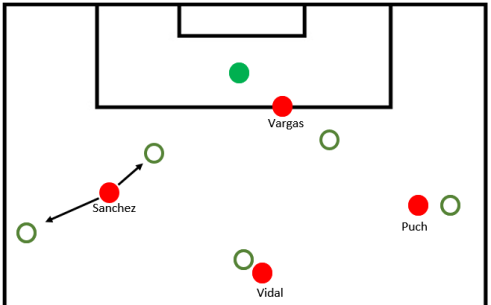
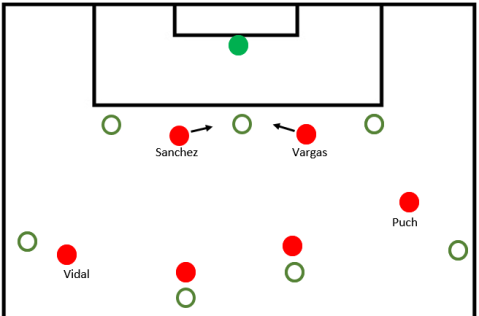
Here’s a video that I prepared which shows how Chile’s aggressive high pressing that resulted in a goal:
Mexico man-marked Chile, had no compactness in defensive phase, and were caught dearly by Chile:
Mexico at times were man-marking Chilean midfield trio and the wingers. While in high-press too, Mexico was too much man-oriented leaving small gaps for Chile to play through. Once, Sanchez dropped deep to shrug off his marker Aguilar and was successful in doing so and quickly attacked the space made free. Layun too, marking Puch, took advanced positions and was lost in transitions as Chile attacked.
Mexico’s man-marking was hurting its defensive shape. While there were holes being created in the middle, it was the flanks where Chile found more open spaces to attack. through.
One of the other serious issues with Mexico was its compactness while in the defensive phase. Mexico’s problems in space occupation while in transition – mainly its man-marking was leading to irregular defensive shapes with poor compactness. Chile was able to pass freely during the counter attacks. Herrera’s high positioning coupled with open spaces in the middle and man-marking was troubling Mexico.
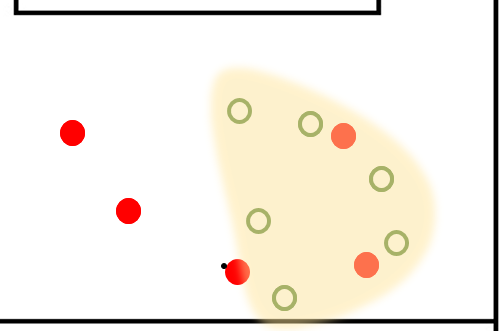
Even during Chile’s initiation of attacks from the back, Mexico was noncompact with loads of space between the three lines of their formation.
Chile positionally dynamic – switched between various shapes in the match, Mexico man-oriented while defending:
Since Puch was playing on the right, in the beginning, it looked as if Chile was playing with a 4-4-2, which was quite astonishing and rare for a team with such talented midfielders. But as the game progressed, Sanchez started to drift out towards the wide spaces on the left and Puch advanced to join alongside Vargas on the right. Chile was playing a 4-3-3 system with Aranguiz and Vidal at central midfield in front of Diaz. Vidal and Aranguiz were regularly swapping their positions in order to stay away from and confuse their markers.
In the later stages of the game Chile, in order to beat the high pressing Mexicans and make way for smooth ball progression from the back, began to alter its shape. The presence of crafty midfielder and defenders who are good at playing the ball made the transition of Chile from one shape to another very easy.
Chile tried to keep at least two players in the near side half-space so as to provide diagonal and vertical options for the players. It also helped the players in escaping the pressure put on by Mexico and move the ball to the free players. With their half-space orientation, while attacking, the Chilean players opened up space in the central regions, thanks to the man-marking done by Guardado and Herrera on Vidal and Aranguiz. There were a lot of vertical passes played through the centre.
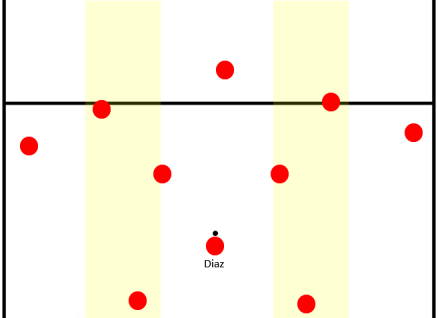
Sometimes, while having ball possession, Chile had three players in the half-spaces, which just added quality to the already existent attacking structure. Chile was able to exploit spaces and create openings. When pressed, each Chile player had at least three passing options. The dotted lines in the diagram show the possible vertical passes. Chile players at the back used such vertical passing lanes excellently. Two situations that I clearly remember are –
- when Medel was in Aranguiz’s place he spotted Puch and Vargas in a 2v2 situation against Mexican defenders and quickly played a vertical pass to create a scoring chance.
- again Medel played a similar pass to free Sanchez and this move ended as a goal.
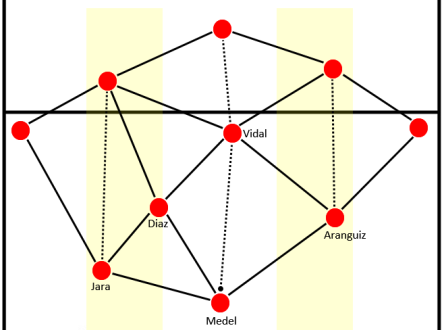
The advanced positioning that the Chilean wingbacks Beausejour and Fuenzalida were taking during the attacking phase helped Sanchez and Puch in moving closer to Vargas and narrowing down the defensive line of Mexico. Unlike what Italy did the other day against Sweden, the central midfielders didn’t move out to wider positions and stuck to their central roles. This was forcing Mexico to maintain numbers in the middle in order to deny Chile the chance to progress the passing sequence through the middle. This, in turn, was putting Mexican wingers in a limbo so as to follow the advancing opposition wingbacks or to tuck into the midfield to provide numerical superiority and force out Chile from the region. Chile players were able to numerically match Mexico upfront and wait for passes to arrive at them to create havoc.
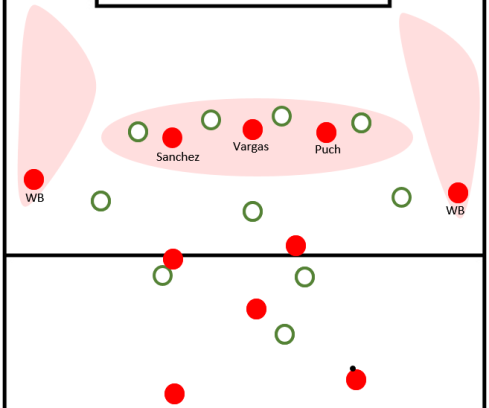
Chile, observing Mexican tendency to man-mark, tried to play a lot of their attacks in the half-spaces. This forced Mexico to move after the Chileans. By overloading one half-space and region around it, Chile was able to open spaces in the far-side wing for the wingback to attack. Narrow at the back due to overloading by Puch, Sanchez and Vargas, Mexican defenders found it tough stop the exploits of Chilean midfielders.

Mexico too much dependent on crosses:
One of the features of this team of Osorio was it’s dependence on crosses to create scoring chances. Against Uruguay, Mexico’s first goal was created from the wings after Guardado and Corona had managed to confuse Maxi Rodriguez.
Against Chile too, even Mexico’s Guardado and Herrera were having ball possession in the half-spaces, they were not looking for inward passing options towards the centre or the penalty box. But instead, the focus was on passing to the man on the wing. If the man on the wing was engaged by Chile’s wide players, then the intention was to somehow free him so as to send in crosses for the forwards.
Passing the ball to the wings is moving the ball away from the goal and into a position where the angle is too tight. From there, in order to beat a compact defense, crossing is the only viable option. Ha! Crossing is also the least effective way of scoring.
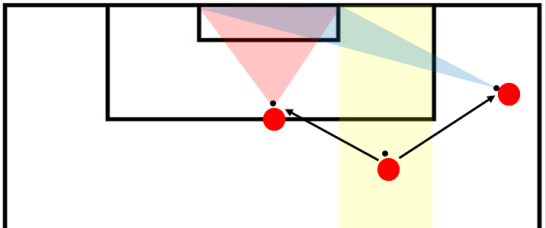
Chile overloaded the ball-near wing:
As Mexico tried to claw back into the game, when the game was still 1-0, there were a few moments when Chile stopped pressing high and allowed Mexico to have ball progression from the back. But since Chile players had the idea about Mexico’ attacking pattern, they overloaded the wing where the ball was played. This was Chile was pushing Mexico back to the middle third and was pressing the player receiving the reverse pass.
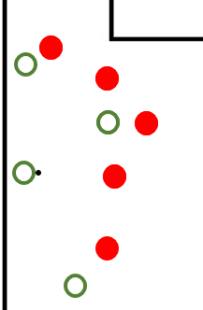
Conclusion:
Mexico’s, playing expansive football, didn’t have a proper plan to counter-press to stop Chile from attacking on the break. Osorio’s non-existent Plan-B hurt his side the most. Mexico pressed high but couldn’t stop Chile from overrunning them at the back by playing vertical passes.
Chile on the other hand are coming back to form at the right stage of the tournament. It was a really cracking game. For every Mexican playing feature which could’ve been a problem to them, Chile had a solution in hand – build-up from the back (check), blocking central access (check), not allowing free player in the wings (check), exploiting their weakness to verticality (check). Chile was destructive. Chile was ruthless. Chile was once again like the Chile under Sampaoli.
Chile was destructive. Chile was ruthless. Chile was once again like the Chile under Sampaoli. Chile was HEAVY METAL FOOTBALL.

Reading this it seems like Mexico are playing really bad football, depending on crosses and man-marking. But when i watched them against Uruguay they were quite good, even with some Juego de Posicion principles. So how do you explain this dramatic change?
LikeLike
While attacking, as I have said, their positions were good. If you have read this completely, then you might have noticed that I have mentioned something about their attacking pattern. Mexico played following some JdP principle but they tried to achieve the end product of scoring a goal by attaining numerical advantage on the wings and not in the central regions. I didn’t say they were playing a generic 4-4-2. Moreover, JdP principles are nothing but common principles like space opening, advantage creation in certain zones which are used even by non-JdP playing teams.
The fact that they were not having the ball was pushing them to somehow get it. Not always, but at many crucial points, Mexican players were man-marking – especially the midfielders and wingbacks.
Keep reading my blog 🙂
LikeLike